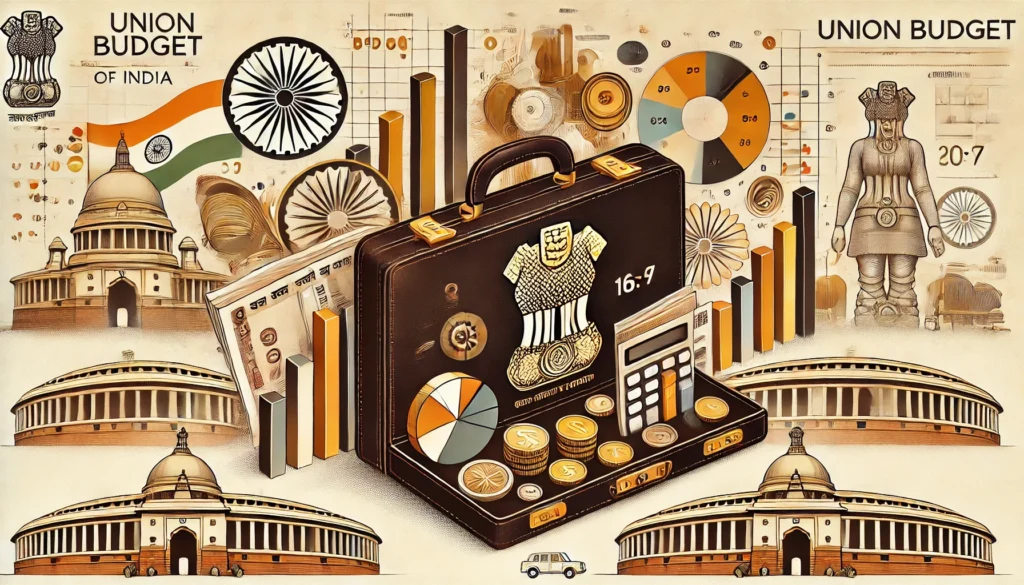
What is the Union Budget?
Generally, in the last week of the month, people get their salaries. At this juncture, households plan their anticipated expenses for the entire month. They allocate money for different expenditures according to their priorities. Moreover, if the requirements are not met by the salary and savings money is borrowed, or if there is already a debt, then some amount of salary is used for amortization. Besides all these intended expenses, if there is some amount left, then that is used for investing or kept as savings or contingency funds. We refer to this periodic calculation plan as a budget. In place of the household, if this planning is done for the entire country, then it’s called the Union Budget.
The Financial Statement
Nowhere in the Indian Constitution, the term budget is mentioned. However, Article 112 of the constitution talks about the Annual Financial Statement, which is actually the Union budget. It is a comprehensive statement including the estimated expenses, receipts, and revenues of the Government of India for the upcoming fiscal year. The Government in this Financial Statement can introduce new Schemes and alterations in the taxation process.
Process of Introducing and Passing The Union Budget
The planning and approval of the Indian Union budget is not as simple as the household one. This process is quite complex as it directly involves hundreds of people and has its effects across the globe. The Finance Minister of India presents the budget in the parliament. Then parliament has to pass the budget by the 31st of March after three readings (Introduction, Discussion, and Voting). The budget has to be passed by March 31 because it is the last day of the fiscal year, and from April 1, the government will be left without funds. Therefore, the Parliament, by passing the budget before the beginning of April, allows the government to withdraw funds from the Consolidated Fund of India to meet the expenses of the next fiscal year commencing from 1st April.
The Halwa Ceremony
Before presenting the budget, the Finance Ministry consults with various departments, ministries, and other stakeholders. After the discussion and planning of 4-6 months, the budget is sent for printing, which is commenced with a unique tradition called the Halwa Ceremony. This ceremony involves the preparation and distribution of halwa to all the officials involved in the budget preparation.
Funds of India
Households collect their sum of money in bank accounts, lockers, etcetera. And withdraw the amount from those funds whenever needed to meet the requirements. Similarly, the Government of India keeps money in three different funds.
Consolidated Fund of India– Article 266 of the Indian Constitution establishes the Consolidated Fund of India as the primary reservoir for all the revenues of the government, including taxes, fees, duties, and interest, along with the funds borrowed by the government. The money in this fund is utilized to cover all the routine expenses of the government, such as salaries, pensions, infrastructure development, defense expenses, judicial expenses, and many more. The resources in the consolidated fund of India can only be accessed with the parliament’s assent, which is obtained by Appropriation Bills.
Contingency Fund of India– We all collect some money as an emergency fund to deal with unforeseen expenditures. Likewise, the Indian Government has an emergency fund named the Contingency Fund of India. Established under Article-267 in 1950, this fund is used to meet the unexpected expenses of the state* such as natural calamities or the adoption and development of new technologies. Secretary of Economic Affairs, on behalf of the President of India, administers this Fund.
Public Account of India– The money that the people of India deposit in various pre-deposits under national savings funds, reserve funds, or provident funds is credited to the Public Account of India. Clause 2 of Article 266 constitutes this fund. These funds do not belong to the government, and hence, access to them doesn’t need parliament’s approval. The Department of Expenditure (DoE) and Controller General of Accounts (CGA) are the main entities having the authority to administer these Funds.
Bills of The Union Budget
Bills are proposals by lawmakers to make new policies or modify existing ones. These bills, when approved by the parliament, become laws that can be enforced or implemented. The Union Budget primarily comprises two types of bills.
Appropriation Bill– The government introduces this bill in the parliament after the discussion on the Demand for Grants is done. An appropriation bill is also known as a supply bill or spending bill. It gives power to the government to withdraw funds from the Consolidated Fund of India
Finance Bills– It is the proposal of the government to the parliament for the modification of the existing tax structure and continuation of the existing tax structure beyond the period approved by the parliament. Additionally, it also introduces new schemes and policies. This bill can only be introduced in the lower house(Lok Sabha) of the parliament. Moreover, it has to be passed within 75 days of introduction.
Interim Budget
During the year of general elections, the government, which is in its last few months in office before the elections, brings an interim budget instead of a regular budget. The new government formed has the authority to present a full-fledged budget after taking office. Therefore, to ensure the uninterrupted continuation of financial activities of the state* an interim budget is tabled in the parliament. The government can propose alterations to the existing tax structure and introduce new policies in the interim budget.
The Bottom Line
The Union Budget is the cornerstone of Governance. It is a vital tool for economic planning and public welfare. Defining the direction for the country’s development affects individuals and influences global trade. Therefore, it requires meticulous planning and dedicated discussions for months.
Image Credit – ChatGPT
State* here represents India according to Article 12 of the Indian Constitution.



Done a great research !